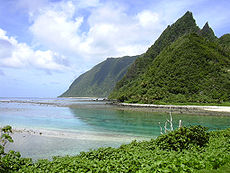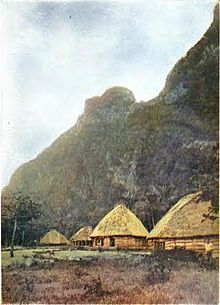| Ofu-Olosega | |
|---|---|
 Ofu-Olosega from the Space Shuttle Ofu-Olosega from the Space Shuttle | |
| Highest point | |
| Elevation | 639 m (2,096 ft) |
| Prominence | 639 m (2,096 ft) |
| Coordinates | 14°10′30″S 169°37′05″W / 14.175°S 169.618°W / -14.175; -169.618 |
| Geography | |
| Location | American Samoa |
| Topo map | USGS |
| Geology | |
| Mountain type | Shield volcanoes |
| Last eruption | September to November 1866 |
Ofu and Olosega are parts of a volcanic doublet in the Manuʻa Islands, which is a part of American Samoa in the Samoan Islands. These twin islands, formed from shield volcanoes, have a combined length of 6 km and a combined area of 12 square kilometers (5 square miles). Together, they have a population of about 500 people. Geographically, the islands are volcanic remnants separated by the narrow, 137-meter-wide (449-foot)) Āsaga Strait, composed of shallow-water coral reef. Before 1970, people crossed between the two islands by waiting until low tide and then wading across the shallow water of the strait. Since 1970, there has been a bridge over the strait, providing a single-lane road that connects the two islands.
The highest peak on Ofu Island is Mount Tumutumu (also called Tumu), at 491 m (1,611 ft). The highest peak on Olosega is Mount Piumafua, at 629 m (2,064 ft). The most recent volcanic eruption was in 1866, 3 km (1.9 mi) southeast of Olosega.
Pre-historic artifacts discovered on Ofu by archaeological field work in the 1980s significantly furthered understanding of the ancient history of Ofu in particular, and the Samoa Islands and Polynesia in general. The artifacts include ceramics, adzes, and worked shell and bone pieces. Samples of red-slipped plainware ceramics were found that appear to have been crafted in the tradition of the Lapita culture. The field work, carried out by a team that included Pacific archaeology specialist Patrick Vinton Kirch, focused on a site called To'aga (site AS-13-1), a 2 km (1.2 mi) coastal stretch on the south coast of Ofu. Dating of the artifacts suggested that Ofu has been continuously inhabited by humans for about 3,000 years.
Ofu

Ofu is the western part of the volcanic outcrop of Ofu-Olosega Island and the westernmost of the Manu'a Islands. The main village of Ofu is located on the western shore, protected behind an offshore islet (eroded tuff cone) known as Nuʻutele Island. Ofu has a small airport (IATA: OFU, ICAO: NSAS) and a boat harbor that serve the population on Ofu and Olosega. The twice-weekly flight from Pago Pago takes about half an hour.

Most of the southern shore and associated coral reef are part of the National Park of American Samoa.
The island forms the Ofu County subdivision of the Manuʻa District. It has a land area of 7.215 km (2.786 sq mi), and had an official population of 176 persons as of the 2010 census.
Situated on the south coast of the island is To'aga lagoon which has a high diversity of corals and fishes. The marine site has been part of long term research and study on coral reefs and global climate change.
The island is also home to the Samoa Flying-fox (Pteropus samoensis), a species of bat threatened by habitat loss.
Olosega

Olosega is the smallest island in the Manuʻa Islands. It is possible to walk across to Ofu Island at low tide. The name derives from Samoan ʻOlosega, "fortress of parakeets."
Olosega Island is a remnant of the Sili shield volcano, the caldera of which may lie submerged off the north shore.
The volcanic eruption of 1866 was actually 3 km (1.9 mi) east of Olosega, on a mid-ocean ridge that extends east southeast to nearby Taʻū.
The island forms the Olosega County subdivision of the Manuʻa District. It has a land area of 5.163 km (1.993 sq mi), and had an official population of 172 persons as of the 2010 census.
Almost all the population of Olosega now reside in Olosega village along the southwestern-facing shore. Olosega also has Olosega Elementary School with instruction through grade 8 for children on both islands.
Sili, situated on the northwestern-facing shore, consists of but one standing inhabited residence after much of the village was destroyed by cyclones (and subsequently abandoned).
Lalomoana and Faiava are other named places but are not inhabited.
Gallery
References
- "Global Volcanism Program, Ofu-Olosega". Smithsonian National Museum of Natural History. Retrieved 13 July 2010.
- Jason Tyler, Patric V. Kirch, Terry L. Hunt, Lisa Nagaoka (November 1989). "Final Report on Archaeological Investigations at Site AS-13-1, To'aga, Ofu Island, American Samoa". Department of Parks and Recreation, Government of American Samoa. Retrieved 13 July 2010.
{{cite web}}: CS1 maint: multiple names: authors list (link) - ^ Hills, J.W. (2010). O upu muamua i le Tala i le Lalolagi mo e ua faatoa a'oa'oina u lea mataupu: Elementary Geography. Nabu Press. Page 63. ISBN 9781147952896.
- Holmes, Lowell D. (1974). Samoan Village. Holt McDougal. Page 3. ISBN 9780030779251.
- Churchill, William (1913). "Geographical Nomenclature of American Samoa". Bulletin of the American Geographical Society. 45 (3): 187–193. doi:10.2307/199273.
- as.geoview.info/olosega_elementary_school,5881559
External links
- Office of the Governor. 2004. Manu'a ma Amerika. A brief historical documentary. Manu'a Centennial. 16 July 1904. 16 July 2004. Office of the Governor, American Samoa Government. 20 p.
- "Ofu-Olosega". Global Volcanism Program. Smithsonian Institution.
- National Park Service map of the Manu'a Islands
- Persistence of Coral Reefs Under Extreme Environmental Stress in American Samoa Archived 2005-02-12 at the Wayback Machine G. Piniak, C. Birkeland, and G. Garrison (2004). University of Hawaii.





